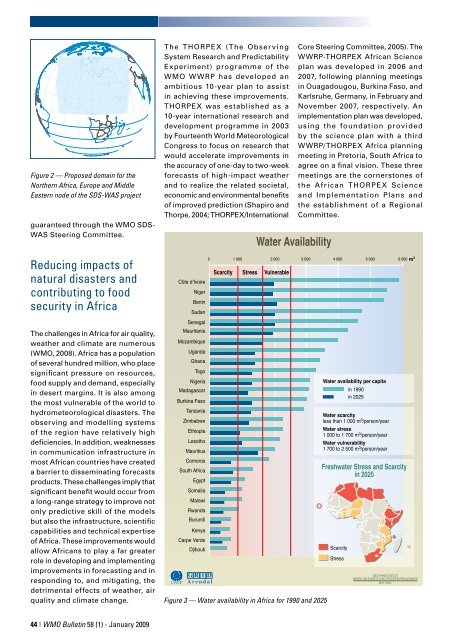Weather, climate and the air we breathe - WMO
Weather, climate and the air we breathe - WMO
Weather, climate and the air we breathe - WMO
You also want an ePaper? Increase the reach of your titles
YUMPU automatically turns print PDFs into web optimized ePapers that Google loves.
Figure 2 — Proposed domain for <strong>the</strong><br />
Nor<strong>the</strong>rn Africa, Europe <strong>and</strong> Middle<br />
Eastern node of <strong>the</strong> SDS-WAS project<br />
guaranteed through <strong>the</strong> <strong>WMO</strong> SDS-<br />
WAS Steering Committee.<br />
Reducing impacts of<br />
natural disasters <strong>and</strong><br />
contributing to food<br />
security in Africa<br />
The challenges in Africa for <strong>air</strong> quality,<br />
<strong>we</strong>a<strong>the</strong>r <strong>and</strong> <strong>climate</strong> are numerous<br />
(<strong>WMO</strong>, 2008). Africa has a population<br />
of several hundred million, who place<br />
significant pressure on resources,<br />
food supply <strong>and</strong> dem<strong>and</strong>, especially<br />
in desert margins. It is also among<br />
<strong>the</strong> most vulnerable of <strong>the</strong> world to<br />
hydrometeorological disasters. The<br />
observing <strong>and</strong> modelling systems<br />
of <strong>the</strong> region have relatively high<br />
deficiencies. In addition, <strong>we</strong>aknesses<br />
in communication infrastructure in<br />
most African countries have created<br />
a barrier to disseminating forecasts<br />
products. These challenges imply that<br />
significant benefit would occur from<br />
a long-range strategy to improve not<br />
only predictive skill of <strong>the</strong> models<br />
but also <strong>the</strong> infrastructure, scientific<br />
capabilities <strong>and</strong> technical expertise<br />
of Africa. These improvements would<br />
allow Africans to play a far greater<br />
role in developing <strong>and</strong> implementing<br />
improvements in forecasting <strong>and</strong> in<br />
responding to, <strong>and</strong> mitigating, <strong>the</strong><br />
detrimental effects of <strong>we</strong>a<strong>the</strong>r, <strong>air</strong><br />
quality <strong>and</strong> <strong>climate</strong> change.<br />
| <strong>WMO</strong> Bulletin 58 (1) - January 2009<br />
The THORPEX (The Observing<br />
System Research <strong>and</strong> Predictability<br />
Experiment) programme of <strong>the</strong><br />
<strong>WMO</strong> WWRP has developed an<br />
ambitious 10-year plan to assist<br />
in achieving <strong>the</strong>se improvements.<br />
THORPEX was established as a<br />
10-year international research <strong>and</strong><br />
development programme in 2003<br />
by Fourteenth World Meteorological<br />
Congress to focus on research that<br />
would accelerate improvements in<br />
<strong>the</strong> accuracy of one-day to two-<strong>we</strong>ek<br />
forecasts of high-impact <strong>we</strong>a<strong>the</strong>r<br />
<strong>and</strong> to realize <strong>the</strong> related societal,<br />
economic <strong>and</strong> environmental benefits<br />
of improved prediction (Shapiro <strong>and</strong><br />
Thorpe, 2004; THORPEX/International<br />
Côte d’Ivoire<br />
Niger<br />
Benin<br />
Sudan<br />
Senegal<br />
Mauritania<br />
Mozambique<br />
Ug<strong>and</strong>a<br />
Ghana<br />
Togo<br />
Nigeria<br />
Madagascar<br />
Burkina Faso<br />
Tanzania<br />
UNEP<br />
Zimbab<strong>we</strong><br />
Ethiopia<br />
Lesotho<br />
Mauritius<br />
Comoros<br />
South Africa<br />
Egypt<br />
Somalia<br />
Malawi<br />
Rw<strong>and</strong>a<br />
Burundi<br />
Kenya<br />
Carpe Verde<br />
Djibouti<br />
G R I D<br />
Scarcity Stress Vulnerable<br />
Water Availability<br />
Core Steering Committee, 2005). The<br />
WWRP-THORPEX African Science<br />
plan was developed in 2006 <strong>and</strong><br />
2007, following planning meetings<br />
in Ouagadougou, Burkina Faso, <strong>and</strong><br />
Karlsruhe, Germany, in February <strong>and</strong><br />
November 2007, respectively. An<br />
implementation plan was developed,<br />
using <strong>the</strong> foundation provided<br />
by <strong>the</strong> science plan with a third<br />
WWRP/THORPEX Africa planning<br />
meeting in Pretoria, South Africa to<br />
agree on a final vision. These three<br />
meetings are <strong>the</strong> cornerstones of<br />
<strong>the</strong> African THORPEX Science<br />
<strong>and</strong> Implementation Plans <strong>and</strong><br />
<strong>the</strong> establishment of a Regional<br />
Committee.<br />
0 1 000 2 000<br />
3 000 4 000 5 000 6 000 m3 Water availability per capita<br />
in 1990<br />
in 2025<br />
Water scarcity<br />
less than 1 000 m3 /person/year<br />
Water stress<br />
1 000 to 1 700 m3 /person/year<br />
Water vulnerability<br />
1 700 to 2 500 m3 /person/year<br />
Freshwater Stress <strong>and</strong> Scarcity<br />
in 2025<br />
Scarcity<br />
Stress<br />
DELPHINE DIGOUT<br />
BASED ON A SKETCH BY PHILIPPE REKACEWICZ<br />
Arendal MAY 2002<br />
Source: United Nations Economic Commission for Africa (UNECA), Addis Abeba ; Global Environment Outlook 2000<br />
(GEO), UNEP, Earthscan, London, 1999.<br />
Figure 3 — Water availability in Africa for 1990 <strong>and</strong> 2025

















